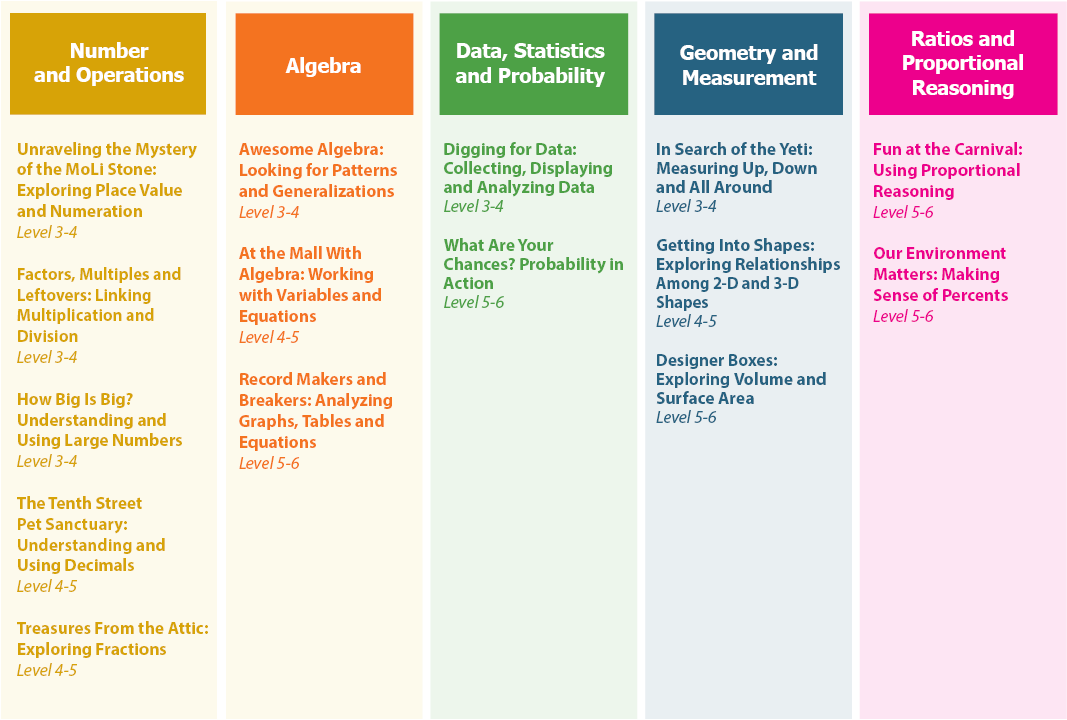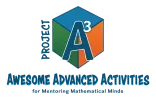
Project M3: Mentoring Mathematical Minds Second Edition
Grade Levels: Elementary
PROGRAM FEATURES

PROGRAM FEATURES
The second edition of Project M3: Mentoring Mathematical Minds provides classrooms with components and resources to increase student understanding across all mathematical themes in each of the units.
Teacher Components
Available in print or as an eBook, the Teacher Guide includes new teacher lesson supports to guide planning and instruction with newly available digital components. Easily provide background information on the problems being taught, the learning environment, mathematical communication, and differentiation. Connections to the Common Core State Standards are also clearly defined throughout each unit.
Student Components
The Student Mathematician's Journal is available as a print component or as an all-new eBook that allows students to explore concepts and real-life problems from any type of learning environment to think, write, and read like mathematicians.
Interactive Activities
Digital resources available, including interactive digital games to support repeated key topics.

In grades 3 through 4, students study number and operations and receive a taste of algebra.
- In Unraveling the Mystery of the MoLi Stone: Exploring Place Value and Numeration, students explore the numeration system in depth and discover a stone with unusual markings. By the end of the unit, students uncover the mysteries found on the stone by applying and extending their new knowledge of place value.
- In Factors, Multiples, and Leftovers: Linking Multiplication and Division, students develop their number sense with a deeper understanding of multiplication and division. They learn about the relationship between multiplication and division and the properties associated with the operations.
- How Big is Big: Understanding and Using Large Numbers introduces students to numbers 1,000 to 1,000,000 using a variety of models and operations. Applying their previous understanding of place value and extend learning of the relative size of numbers in each place up to one million.
- In Awesome Algebra: Looking for Patterns and Generalizations, students study patterns and determine how they change, can be extended or repeated, and how they grow.
- In Search of the Yeti: Measuring Up, Down and All Around, measurement is focused on learning about perimeter, area, and volume.
- Digging for Data: Collecting, Displaying and Analyzing Data, students explore the world of the research scientist and learn how gathering, representing, and analyzing data are the essence of good research.
- Unraveling the Mystery of the MoLi Stone
- Factors, Multiples & Leftovers
- How Big is Big?
- Awesome Algebra
- In Search of the Yeti
- Digging for Data
FOR EACH CLASSROOM/TEACHER
-
Project M3: Level 3-4: Unraveling the Mystery of the Moli Stone: Exploring Place Value and Numeration Card Set
-
Project M3: Level 3-4: Unraveling the Mystery of the MoLi Stone: Exploring Place Value and Numeration Teacher 3 Year License
-
Project M3: Level 3-4: Unraveling the Mystery of the MoLi Stone: Exploring Place Value and Numeration Teacher Guide + 3 Year License
-
Project M3: Level 3-4: Unraveling the Mystery of the Moli Stone: Place Value and Numeration Kit
FOR EACH STUDENT
CUSTOMIZED SHOPPING FOR:
Unraveling the Mystery of the MoLi Stone
ADD THE FOLLOWING:
FOR EACH CLASSROOM/TEACHER
-
Project M3: Level 3-4: Factors, Multiples and Leftovers: Linking Multiplication and Division Card Set
-
Project M3: Level 3-4: Factors, Multiples and Leftovers: Linking Multiplication and Division Teacher 3 Year License
-
Project M3: Level 3-4: Factors, Multiples and Leftovers: Linking Multiplication and Division Teacher Guide + 3 Year License
CUSTOMIZED SHOPPING FOR:
Factors, Multiples & Leftovers
ADD THE FOLLOWING:
FOR EACH CLASSROOM/TEACHER
-
Project M3: Level 3-4: How Big Is Big? Understanding and Using Large Numbers Manipulative Kit
-
Project M3: Level 3-4: How Big Is Big? Understanding and Using Large Numbers Card Set
-
Project M3: Level 3-4: How Big is Big? Understanding and Using Large Numbers Teacher 3 Year License
-
Project M3: Level 3-4: How Big is Big? Understanding and Using Large Numbers Teacher Guide + 3 Year License
CUSTOMIZED SHOPPING FOR:
How Big is Big?
ADD THE FOLLOWING:
FOR EACH CLASSROOM/TEACHER
-
Project M3: Level 3-4: Awesome Algebra: Looking for Patterns and Generalizations Teacher 3 Year License
-
Project M3: Level 3-4: Awesome Algebra: Looking For Patterns and Generalizations Card Set
-
Project M3: Level 3-4: Awesome Algebra: Looking For Patterns and Generalizations Kit
-
Project M3: Level 3-4: Awesome Algebra: Looking for Patterns and Generalizations Teacher Guide + 3 Year License
CUSTOMIZED SHOPPING FOR:
Awesome Algebra
ADD THE FOLLOWING:
FOR EACH CLASSROOM/TEACHER
-
Project M3: Level 3-4: In Search of the Yeti: Measuring Up, Down and All Around Card Set
-
Project M3: Level 3-4: In Search of the Yeti: Measuring Up, Down and All Around Teacher 3 Year License
-
Project M3: Level 3-4: In Search of the Yeti: Measuring Up, Down and All Around Teacher Guide + 3 Year License
CUSTOMIZED SHOPPING FOR:
In Search of the Yeti
ADD THE FOLLOWING:
FOR EACH CLASSROOM/TEACHER
-
Project M3: Level 3-4: Digging for Data: Collecting, Displaying and Analyzing Data Teacher 3 Year License
-
Project M3: Level 3-4: Digging for Data: Collecting, Displaying and Analyzing Data Teacher Guide + 3 Year License
-
Project M3: Level 3-4: Digging for Data: Collecting, Displaying and Analyzing Data Card Set
-
Project M3: Level 3-4: Digging for Data: Collecting, Displaying and Analyzing Data Manipulative Kit
CUSTOMIZED SHOPPING FOR:
Digging for Data
ADD THE FOLLOWING:
In grades 4 through 5, students continue on the same learning paths fostered previously.
- In The Tenth Street Pet Sanctuary: Understanding and Using Decimals, students are introduced to how the decimal numeration system takes place. Students learn how the powers of 10 are used to create decimals and understand the role of the decimal point as the marker for the end of whole numbers.
- At the Mall with Algebra: Working with Variables and Equations, students discover the mathematics behind number tricks and variable puzzles. The experiences and discussions provide a rich context for introducing students to algebraic thinking while strengthening their problem solving and mathematical communication skills.
- In Treasurers from the Attic: Exploring Fractions, students are introduced to the characters of Tori and Jordan, who uncover hidden treasures in their grandparents' attic from a general store that their great-grandparents used to own. The unit focuses on making sense of fractions rather than on learning algorithms to perform computations.
- Getting Into Shapes: Exploring Relationships Among 2-D and 3-D Shapes, students explore 2-and 3-dimensional shapes with a focus on their properties, relationships among them and spatial visualization. The reasoning skills built on in this unit, help them develop an understanding of more complex geometric concepts.
FOR EACH CLASSROOM/TEACHER
-
Project M3: Level 4-5: The Tenth Street Pet Sanctuary: Understanding and Using Decimals Card Set
-
Project M3: Level 4-5: Treasures From The Attic: Exploring Fractions Manipulative Kit
-
Project M3: Level 4-5: The Tenth Street Pet Sanctuary: Understanding and Using Decimals Teacher 3 Year License
-
Project M3: Level 4-5: The Tenth Street Pet Sanctuary: Understanding and Using Decimals Teacher Guide + 3 Year License
CUSTOMIZED SHOPPING FOR:
Tenth Street Pet Sanctuary
ADD THE FOLLOWING:
FOR EACH CLASSROOM/TEACHER
-
Project M3: Level 4-5: At the Mall With Algebra: Working With Variables and Equations Teacher Guide + 3 Year License
-
Project M3: Level 4-5: At the Mall With Algebra: Working With Variables and Equations Teacher 3 Year License
-
Project M3: Level 4-5: At the Mall With Algebra: Working With Variables and Equations Card Set
CUSTOMIZED SHOPPING FOR:
At The Mall
ADD THE FOLLOWING:
FOR EACH CLASSROOM/TEACHER
-
Project M3: Level 4-5: Treasures from the Attic: Exploring Fractions Teacher Guide + 3 Year License
-
Project M3: Level 4-5: Treasures from the Attic: Exploring Fractions Teacher 3 Year License
-
Project M3: Level 4-5: Treasures From The Attic: Exploring Fractions Manipulative Kit
-
Project M3: Level 4-5: Treasures From the Attic: Exploring Fractions Card Set
CUSTOMIZED SHOPPING FOR:
Treasures from the Attic
ADD THE FOLLOWING:
FOR EACH CLASSROOM/TEACHER
-
Project M3: Level 4-5: Getting Into Shapes: Exploring Relationships Among 2-D and 3-D Shapes Teacher 3 Year License
-
Project M3: Level 4-5: Getting Into Shapes: Exploring Relationships Among 2-D and 3-D Shapes Teacher Guide + 3 Year License
-
Project M3: Level 4-5: Getting Into Shapes: Exploring Relationships Among 2-D and 3-D Shapes Card Set
-
Project M3: Level 4-5: Getting Into Shapes Kit
CUSTOMIZED SHOPPING FOR:
Getting Into Shapes
ADD THE FOLLOWING:
In grades 5 through 6, the mathematical growth continues as students are learning more in depth algebraic and geometrical concepts.
- In Record Makers and Breakers: Analyzing Graphs, Tables and Equations, students learn about algebra as a set of concepts tied to the representation of relationships by words, tables or graphs. It extends their notion of variable from a letter in an equation that represents a number to a more broad definition.
- Fun at the Carnival: Using Proportional Reasoning introduces students to similarity, congruence, and scale factors and explore ration as a comparison of two quantities. The foundational mathematics behind these concepts is proportional reasoning, and students will learn how to use proportions to solve problems.
- Designer Boxes: Exploring Volume & Surface Area, geometric measurement is the focus. Students build on the work from previous units regarding area and perimeter and extend it to three-dimensional solids. Their abilities to learn spatially improve as they learn about the relationships among faces, vertices and edges of rectangular prisms and how to make and label drawings of boxes.
- Students begin their exploration of probability as a measurement of the likelihood of events in What Are Your Chances? Probability in Action. They move beyond performing simple probability experiments to an understanding of experimental and theoretical probability and the Law of Large Numbers.
- In Our Environment Matters: Making Sense of Percents, students explore percents in depth and see how it is linked to the study of proportionality. Students will make connections to number concepts and algebra as they develop their understanding of percents, connect percents to different representations of the same number using fractions and decimals.
- Record Makers and Breakers
- Fun at the Carnival
- Designer Boxes
- What Are Your Chances?
- Our Environment Matters
FOR EACH CLASSROOM/TEACHER
-
Project M3: Level 5-6: Record Makers and Breakers: Analyzing Graphs, Tables and Equations Teacher 3 Year License
-
Project M3: Level 5-6: Record Makers and Breakers: Analyzing Graphs, Tables and Equations Teacher Guide + 3 Year License
-
Project M3: Level 5-6: Record Makers and Breakers: Analyzing Graphs, Tables and Equations Card Set
CUSTOMIZED SHOPPING FOR:
Record Makers and Breakers
ADD THE FOLLOWING:
FOR EACH CLASSROOM/TEACHER
-
Project M3: Level 5-6: Fun at the Carnival: Using Proportional Reasoning Teacher 3 Year License
-
Project M3: Level 5-6: Fun at the Carnival: Using Proportional Reasoning Teacher Guide + 3 Year License
-
Project M3: Level 5-6: Fun at the Carnival: Using Proportional Reasoning Card Set
-
Project M3: Level 5-6: Fun at the Carnival Manipulative Kit
CUSTOMIZED SHOPPING FOR:
Fun at the Carnival
ADD THE FOLLOWING:
FOR EACH CLASSROOM/TEACHER
-
Project M3: Level 5-6: Designer Boxes: Exploring Volume and Surface Area Teacher 3 Year License
-
Project M3: Level 5-6: Designer Boxes: Exploring Volume and Surface Area Teacher Guide + 3 Year License
-
Project M3: Level 5-6: Designer Boxes: Exploring Volume and Surface Area Card Set
-
Project M3: Level 5-6: Designer Boxes: Exploring Volume and Surface Area Manipulative Kit
CUSTOMIZED SHOPPING FOR:
Designer Boxes
ADD THE FOLLOWING:
FOR EACH CLASSROOM/TEACHER
-
Project M3: Level 5-6: What Are Your Chances? Probability in Action Card Set
-
Project M3: Level 5-6: What Are Your Chances? Probability in Action Manipulative Kit
-
Project M3: Level 5-6: What Are Your Chances? Probability in Action Teacher 3 Year License
-
Project M3: Level 5-6: What Are Your Chances? Probability in Action Teacher Guide + 3 Year License
CUSTOMIZED SHOPPING FOR:
What Are Your Chances?
ADD THE FOLLOWING:
FOR EACH CLASSROOM/TEACHER
CUSTOMIZED SHOPPING FOR:
Our Environment Matters
ADD THE FOLLOWING:
Get More Out of Your Curriculum with KH Professional Learning
At Kendall Hunt, we believe professional learning and curriculum support are essential for a successful implementation. Understanding that educators need time and guidance to integrate new curriculum effectively, and that approach may differ by teacher or school, we are committed to creating a tailored training and support program to meet your unique needs.
Our offerings include a range of high-quality onsite and online sessions for both new and experienced teachers and administrators, ensuring flexibility with virtual, onsite, or blended options.
Why should you invest in Professional Learning?
- Instill self-confidence in new educators and empower the growth of your current educators
- Enhance teacher knowledge and expertise through targeted, custom professional learning
- Encourage collaboration and knowledge-sharing among teachers
- Support the shift from traditional methods to inquiry-based or standards-based approaches
Drive measurable improvements in student achievement
To learn more, please contact us at professionallearning@kendallhunt.com
Don’t miss out! Check out our events page for upcoming professional learning opportunities.
CUSTOMIZED SHOPPING FOR:
Professional Learning
ADD THE FOLLOWING:
Beyond Words
To remove a product, click the 'X' next to the qty of the product.
| QTY | Product | Choose Format |
|---|
* To receive a SALES QUOTE proceed to step 2 of the checkout process.
HOW TO ORDER
Use the order form on this page to add products, by group, to your cart. You will need to choose the product format for each product and then add all products to your shopping cart.
After you have selected your products, you can proceed to the checkout by clicking on the shopping cart.
Note: If a product format states "not available" then the product is not available for sale on the website.
If you would like to receive a Sales Quote for an order, prior to placing your order, you will need to follow these steps:
- Add products to your shopping cart using the Customized Shopping form on this page.
- Go to your shopping cart and proceed to Checkout.
- Log into your existing account, create a new account, or checkout as guest.
- Proceed through checkout and on step 2 you can generate the sales quote by entering your email address.
Request a Trial
Flourish is the digital platform that we use for Project M3: Mentoring Mathematical Minds, Second Edition products. To request 30-day digital access to this program you will be taken off-site to our Flourish Request form.

